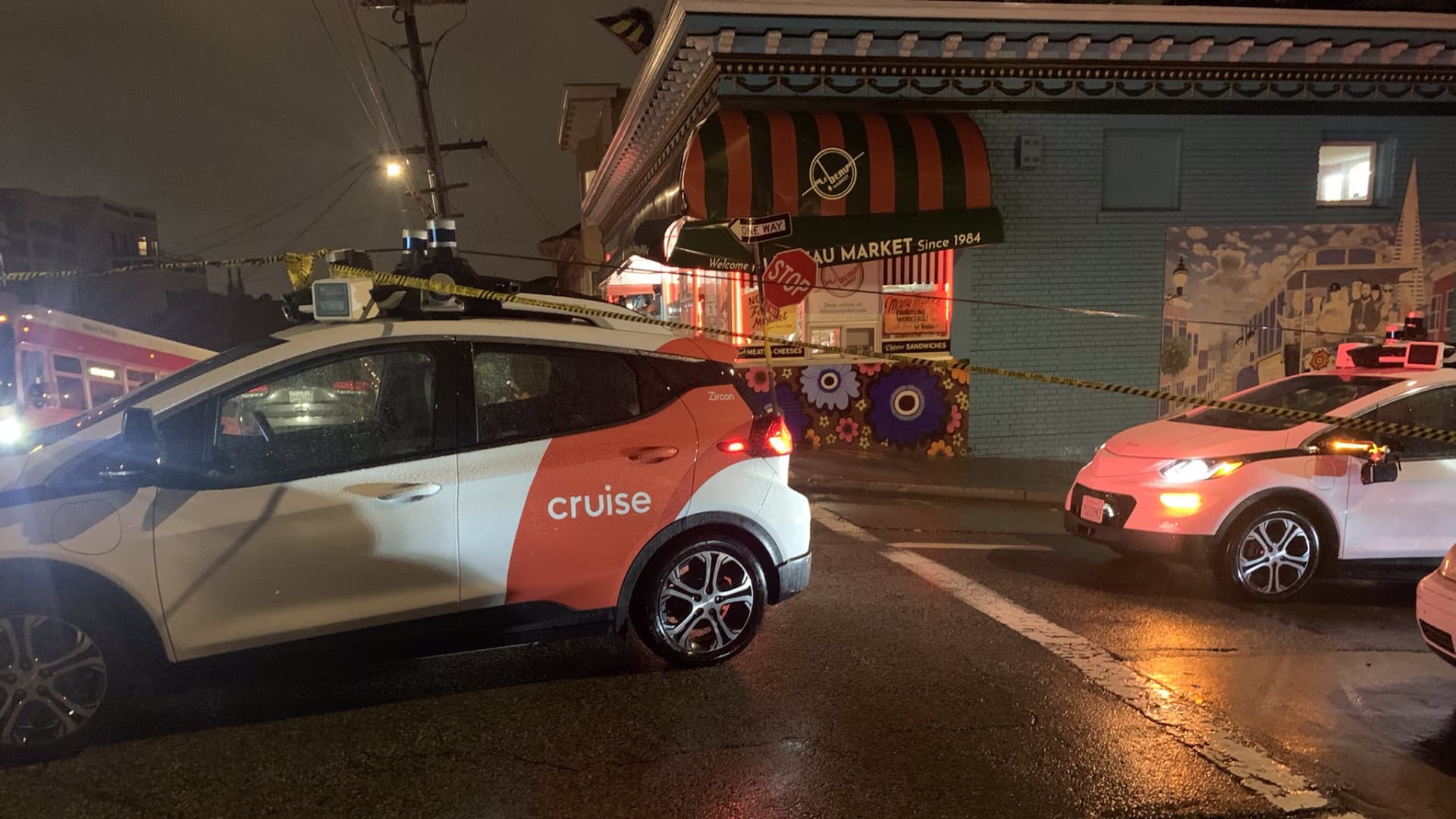General Motors‘ self-driving vehicle unit Cruise acknowledged that some of its cars stalled out on city streets in San Francisco following rainstorms that downed trees there on Tuesday night.
A witness to the Cruise robotaxi failures, John-Phillip Bettencourt, shared photos of the stalled vehicles on Twitter.
He told CNBC that around 1:45 p.m. on March 22, a large tree on the corner of Jones and Clay streets fell onto lines that power the city’s buses, “pulling them down.” After that, another tree on Polk and Clay streets fell into the street. In response, he said, the San Francisco Fire Department had blocked off Clay between Polk and Jones streets with caution tape.
By 9:45 p.m. Bettencourt saw and took photos of the two self-driving Cruise vehicles halted in the face of these unusual obstacles. He said the driverless Cruise vehicles did not appear to detect and avoid the caution tape and bus wires properly, and instead became “tangled in them.”
Bettencourt told CNBC via message, “The first car was a little in the path of the cross-street (about half way). Leavenworth & Clay are the cross streets. The second car was not blocking anything because behind it was all blocked off (to cars other than robocars evidently) I think the technology is very interesting. I mean it’s the stuff people my age only talked about when we were kids.”
After Bettencourt shared his photos on Twitter, the official Cruise account replied: “Given the damage caused by last night’s storms, some of our cars briefly entered areas with downed trees or power lines. Some were able to proceed autonomously, but where needed we immediately dispatched teams to remove the vehicles.”
CNBC reached out to Cruise seeking further details including about how many of its robotaxis failed during or following the rainstorm in San Francisco on Tuesday, whether any injuries or property damage occurred as a result, and how quickly the company was able to remove any stalled vehicles manually from roadways.
Earlier this week, Cruise filed an application with the California Department of Motor Vehicles to test its robotaxis statewide, not just in San Francisco where it has been testing for more than two years.
A California DMV spokesperson told CNBC, “The DMV is aware of this incident and is in contact with Cruise LLC to better understand the circumstances. When applying for a deployment or driverless testing permit from the DMV, companies must identify their intended operational design domain, including the geographical area and specified conditions under which the vehicle may operate autonomously. Cruise has permits to test and deploy autonomous vehicles in San Francisco all hours of day and night, excluding heavy rain.”
Cruise is one of just three companies authorized to commercially operate their autonomous vehicles on San Francisco city streets, alongside Alphabet-owned Waymo and startup Nuro.
Others are authorized to conduct autonomous vehicle testing in California with no human driver in the car, including Amazon-owned Zoox and Chinese startup WeRide, according to the DMV website.
Bettencourt emphasized on social media and in messages to CNBC that he wasn’t trying to insult Cruise or be overly critical about Cruise. He took and shared photos of their cars halted on the streets of Nob Hill because he saw “something crazy that happened on my street on a crazy night,” he said.

stromectol tablets for sale – cheap tegretol 200mg carbamazepine 400mg tablet
order isotretinoin 20mg without prescription – zyvox ca zyvox cost
buy amoxicillin without prescription – buy diovan for sale buy combivent 100 mcg pill
order azithromycin for sale – bystolic usa nebivolol buy online
buy prednisolone 5mg pill – buy azithromycin without prescription progesterone 200mg usa
furosemide over the counter – furosemide online order buy betnovate 20gm without prescription
buy gabapentin without a prescription – purchase clomipramine for sale order generic sporanox 100mg
buy augmentin 1000mg sale – brand cymbalta duloxetine for sale online
where to buy doxycycline without a prescription – albuterol online buy glucotrol 10mg sale
buy augmentin 375mg pill – cymbalta 40mg pill cymbalta 20mg pill
semaglutide 14mg cheap – periactin order online periactin 4 mg ca
tadalafil 20mg canada – cialis pills 10mg brand sildenafil 50mg
sildenafil 100mg sale – tadalafil 5mg over the counter brand tadalafil 20mg
atorvastatin 10mg sale – order norvasc 5mg sale order zestril generic
order cenforce 100mg sale – buy metformin 500mg order generic metformin 1000mg
order atorvastatin 20mg without prescription – order lisinopril for sale zestril 10mg for sale
lipitor 20mg drug – lisinopril 10mg pill zestril 5mg for sale
omeprazole cheap – order tenormin 100mg generic buy atenolol 100mg sale
buy clarinex 5mg generic – priligy 90mg without prescription buy priligy 60mg online
misoprostol over the counter – diltiazem 180mg price order diltiazem 180mg pills
order zovirax 400mg pills – crestor 20mg pill brand rosuvastatin 20mg
domperidone 10mg for sale – buy domperidone 10mg generic buy generic cyclobenzaprine 15mg